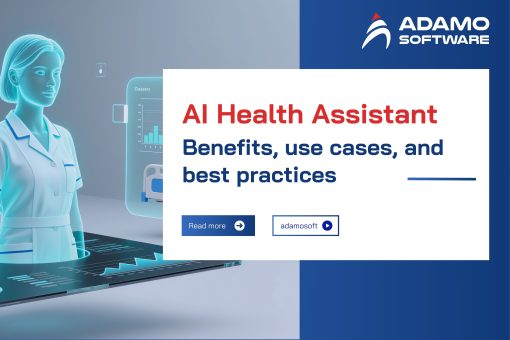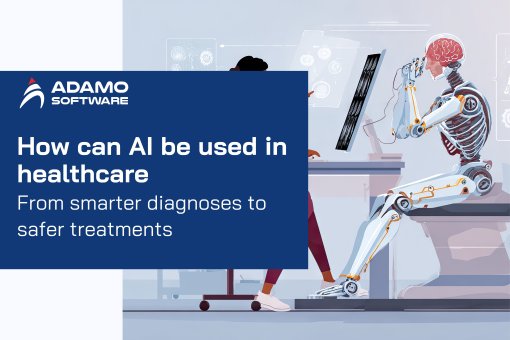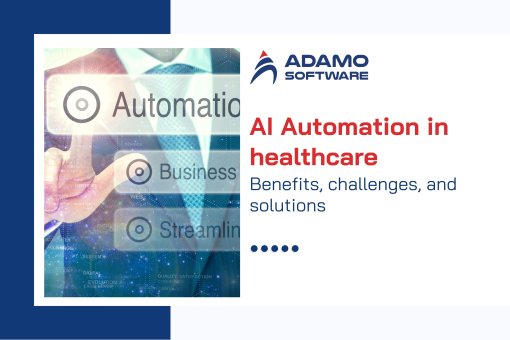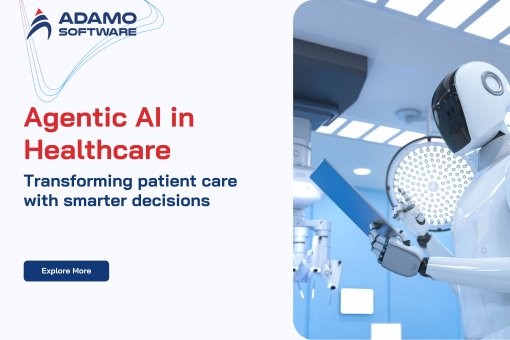AI in EHR: Use cases, tech stacks, and budget considerations
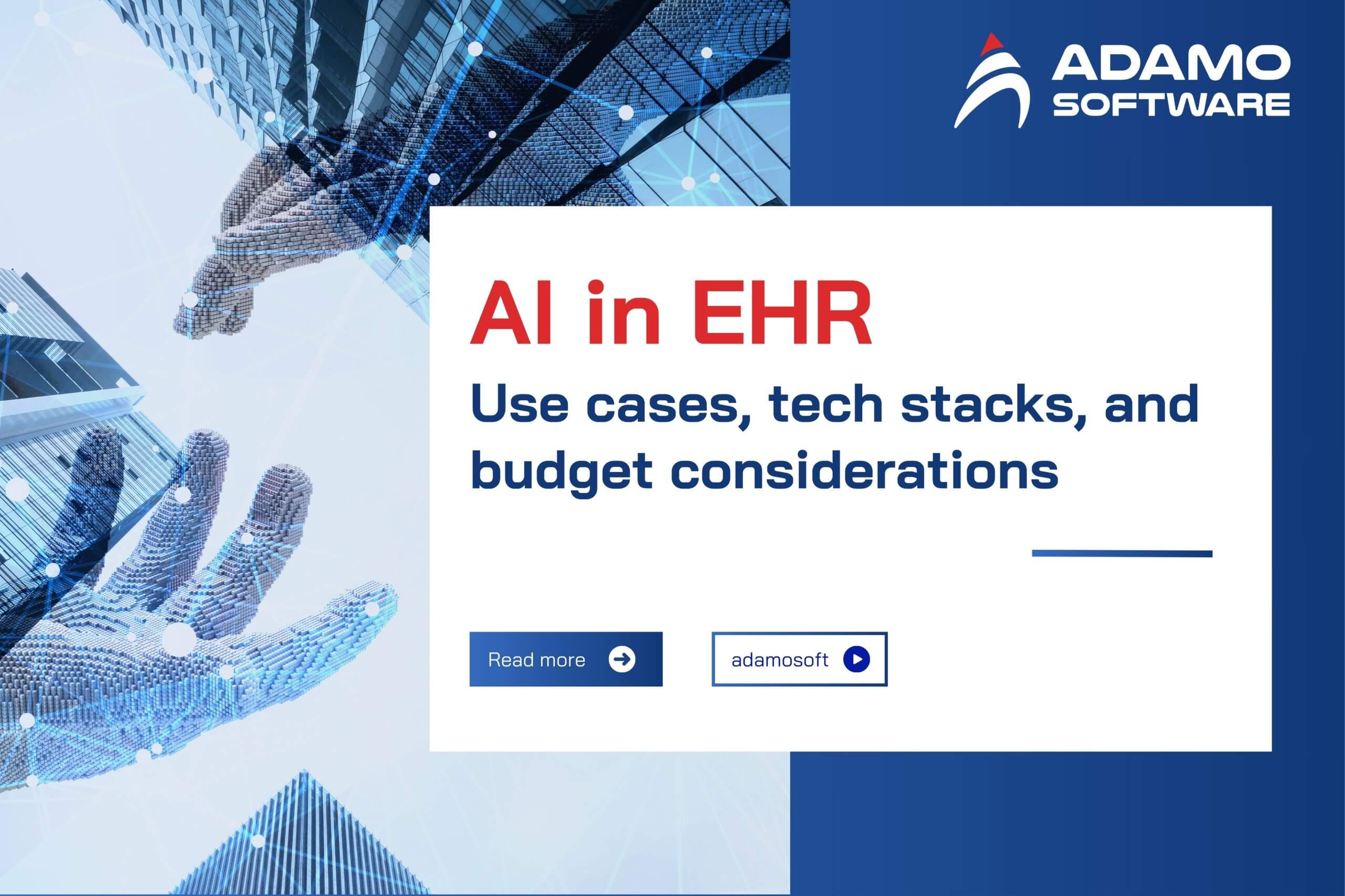
AI in EHR helps doctors save time, improve diagnosis, and enhance patient care. Explore its benefits, challenges, and cost in our complete guide.
AI in EHR is changing how medics store, access, and utilize patient records. EHRs have stopped being digitalized paper charts with artificial intelligence assisting in creating comprehensiveness in the records. They are turning into intelligent systems that can foretell risks of a patient, automate repetitive work, and aid clinical decision-making. Deloitte presents, based on a study conducted in 2024, that more than 60% of the healthcare organizations in the U.S. had already begun to incorporate AI into their EHR systems to both advance the quality of care and decrease administrative expenses.
This is not the only case of AI in EHR established in hospitals. AI is being used in clinics, labs, and in remote care services to manage patient records efficiently. It can identify trends in patient cases, remind the doctors of the treatment protocols, and alert them to the missing data in real time. Since AI is getting less expensive and more widespread, its influence on EHR will continue to increase. The 2024 insights on healthcare presented by McKinsey indicate that AI will save as much as 100 billion dollars in the United States by accelerating, smartening, and making more accurate EHR systems.
In the following insight, we will dive into practical applications of AI to EHR, its advantages, technology stacks, cost development, and how it can be initiated with professional advice.
I. Use Cases of AI in EHR
AI in EHR has been transforming the way care providers process, analyze, and use medical information. It can also help save time, contribute to safer, faster, and more personalized care. The key use cases are here:
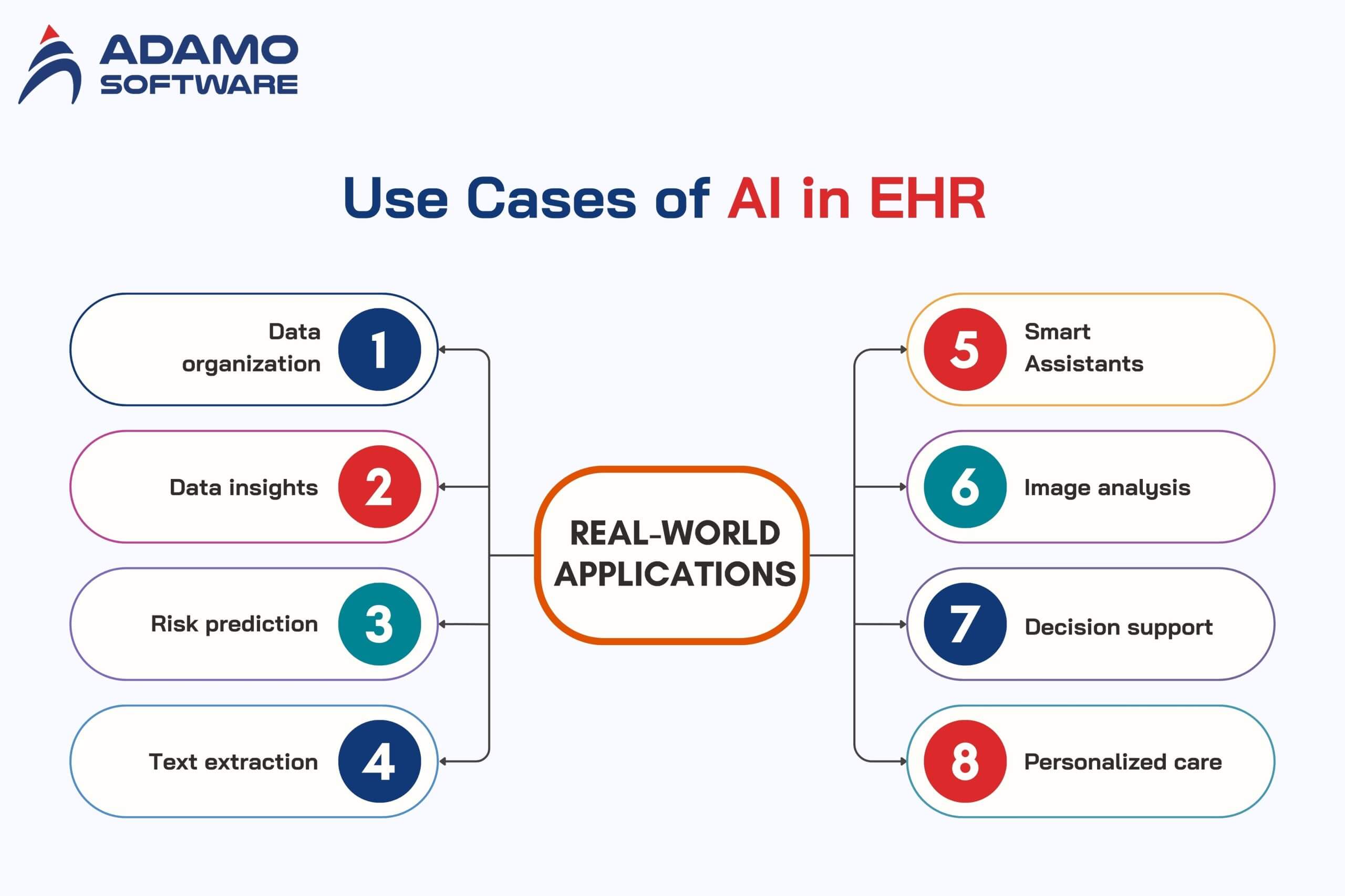
- Data organization – Sorts and structures patient records.
- Data insights – Find hidden patterns for better decisions.
- Risk prediction – Forecasts disease risks early.
- Text extraction – Pulls key data from clinical notes.
- Smart assistants – Automate admin tasks.
- Image analysis – Detects issues in scans.
- Decision support – Suggests treatments or alerts.
- Personalized care – Tailors treatment to each patient.
1. Data Management and Organization
The AIs located in EHR enhance the way the information is organized and displayed. Conventional EHR systems have a tendency to have massive quantities and a variety of information mixed up within them, such as lab reports, prescriptions, diagnoses; all kept in separate fields. AI may clean, and group this data automatically. It is capable of labeling files, finding duplicates, and showing pertinent data at the top. This will enable doctors to locate what they require in a short time, particularly in situations where it is needed, as in an emergency or complicated patient history review.
2. Data Analysis and Insights
EHR AI has the potential to process data provided by numerous points of access such as wearable devices and laboratory tests. It identifies trends and patterns difficult to identify manually. As an example, a patient could be experiencing elevated blood sugar levels but the increase could take place over months-AI would recognize this slowly creeping sign of diabetes and alert to its presence in the early stages. Accenture observed that 72% of the providers could make more sense of complicated data using AI tools, in a report released in 2024.
3. Predictive Analytics
Predictive models based on AI in EHR can predict risks at an early stage, such as indicating patients who might develop heart disease or be readmitted after discharge. It predicts these risks with the help of patient history, genetics, and lifestyle. AI raised the survival rate by 20% compared to the traditional methods of detecting sepsis, with AI detecting the malady 12 to 24 hours sooner than traditional tools, according to a 2024 study published in JAMA Network Open.
4. Natural Language Processing (NLP)
Physicians usually communicate using free-text notes. This unstructured information has all the details but it is difficult to search. EHR applied AI to interpret and extract major patient information such as symptoms, allergies, and previous treatment history using NLP. It makes those notes to be search, fields, and structural data. This assists in making up a working profile of the patient.
5. VMAs
EHR system assistants powered by AI allow for automating routine tasks. They verify the appointments, make updates on records, or provide simple patient questions. This frees the doctors and nurses from the extra strain, avoids human error, and enhances patient satisfaction. It also enables the medical staff to pay more attention to the patients.
6. Computer Image and Signal Analysis
AI use in EHR can be combined with diagnostic instruments that review medical imaging (MRIs or X-rays) and indicators (ECGs). A human eye can be wrong about small abnormalities, and AI is specifically trained to recognize thousands of cases but always manages to notice small details that are not obvious. It results in early identification of such problems as a tumor, heart failure, or internal bleeding.
7. Clinical Decision Support
EHR AI performs the role of a smart advisor. It reads patient information against the medical protocols and studies to propose some possible diagnoses or alert to possible dangers such as medication interactions. It provides real-time evidence-based choices to doctors. This assists in fewer errors and helps make better decisions.
8. Personalized Medicine
All human beings react to medication in different ways. EHR with AI allows the doctor to develop the treatment plan according to genes, medical history, lifestyle, and response to previous treatment. This sensitive method enhances the results and minimizes the side effects. As an example, it has replaced or supplemented the common practice of dose personalization of chemotherapies with AI in a cancer context.
AI in EHR is not merely a matter of automation but it introduces to each level of care an extra dimension of smartness. It assists in structuring information, foreseeing risk, and biting information, aiding judgments, and customizing treatment. Despite the remaining challenges (data privacy and system integration, in particular), the advantages are obvious. In the study in 2024, it was indicated that AI in EHR can support discerning, quick, and non-hazardous decisions in healthcare (Foulds et al., 2024).
You can explore more about How can AI be used in healthcare: From smarter diagnoses to safer treatments here.
Ready to Outsource?
Get top-tier IT talent without the hassle. Contact us now!
II. What are the benefits of AI-powered EHR?
AI in EHR avoids the need to work hard without necessarily counting on evidence-based decisions. It integrates intelligent automation and real-time data insights to eliminate manual processes, make improved decisions, and enhance care delivery. In 2024, EHR AI-powered hospitals exhibit increased efficiency, as well as a reduction in the number of errors and improved patient satisfaction. Such advantages will have effects on the physicians, and the individual patients as well as the overall provision of care.
Here are the main benefits of AI in EHR:
- Reduced workload – Automates routine tasks and saves time.
- Fewer errors – Flags risks and prevents mistakes.
- Smarter decisions – Offers evidence-based suggestions.
- Personalized care – Adapts treatment to individual needs.
- Cost savings – Improves efficiency and reduces waste.
- Better experience – Helps doctors focus on patients.
1. Reduced Clinician Workload & Burnout
AI in EHR systems automates the process of note-making, keeping the records, and managing appointments, which are time-consuming activities. A survey of physicians conducted by the American Medical Association (AMA) found that 65% said AI tools were useful in reducing after-hours shifts that lessened burnout. Such tools as AI-driven scribes may capture and organize conversations in patient visits and provide physicians with additional time to concentrate on human connections and medical work.
2. Fewer Errors & Better Patient Safety
AI in EHR is efficient in avoiding clinical errors. It logs in patient records in real time and informs the doctors of possible drug allergies or drug interactions and doses. A research paper in Nature Digital Medicine demonstrated that AI systems decreased the amount of prescription-related errors by more than 40% in pilot programs at large hospitals. The tools are also helpful in safer care team handoffs since important information is not missed.
3. Faster, Smarter Clinical Decisions
Through AI in EHR, clinicians should not sort hundreds of records manually to make decisions. This system has the potential to examine the lab results, medical histories, and research databases in real-time and provide evidence-based suggestions. AI also accelerates diagnosis procedures. Areas where AI triage tools can make things better include the waiting time of patients in the emergency rooms getting up to a 25% reduction across some hospitals.
4. Personalized, Predictive Care
Through AI in EHR, tailored treatment is possible as data are collected across various sources to generate more information. It can forecast risks like strokes or readmissions in a hospital depending on the specific patterns between the patients. As an example, researchers at Stanford Health are the authors who in 2024 discovered that AI models can accurately predict cardiac events to the tune of 90%, when built into EHR capabilities.
5. Deeper Data Insights & Cost Savings
AI relative to EHR would enable hospitals to operate more intelligently by making them locate inefficiencies and proposing solutions. These entail streamlining the ordering of tests, minimizing unnecessary tests, and focusing on high-risk patients. At the World Economic Forum in 2025, it was estimated that AI systems could help health systems worldwide save up to 150 billion US dollars across the year due to the efficiency of managing waste and coordination systems that would be possible.
6. Enhanced Patient Experience & Engagement
Doctors can interact with patients when background work is done by the AI. Patients can also use virtual assistants to manage medicines, get reminders, and read test results in an easy-to-understand language. This will instill trust and will keep patients more involved in their care. Commonwealth Fund surveyed in 2025 and revealed that patients of AI-supported clinics provide 30% higher satisfaction rates than traditional ones.
AI in EHR is showing its worth at all levels of healthcare. It is made to make systems smarter, clinicians more effective, and care more personalized. Although certain issues are still present, including data privacy and training, the studies conducted in 2025 can state the effect of the AI-powered EHRs on the reduction of errors, workflow, and patient outcomes. AI in EHR is turning into a key to a new era of wise and modern healthcare with proper implementation.
III. Tech stacks for high-performing AI-Driven EHR Development
To design an effective and powerful AI for an EHR system, it is necessary to have the proper technology stack. It should be quick, provide data security, be easily scalable, and be reliable when responding to AI requirements. The building blocks of running and constructing high-performing AI-powered EHR software are below.
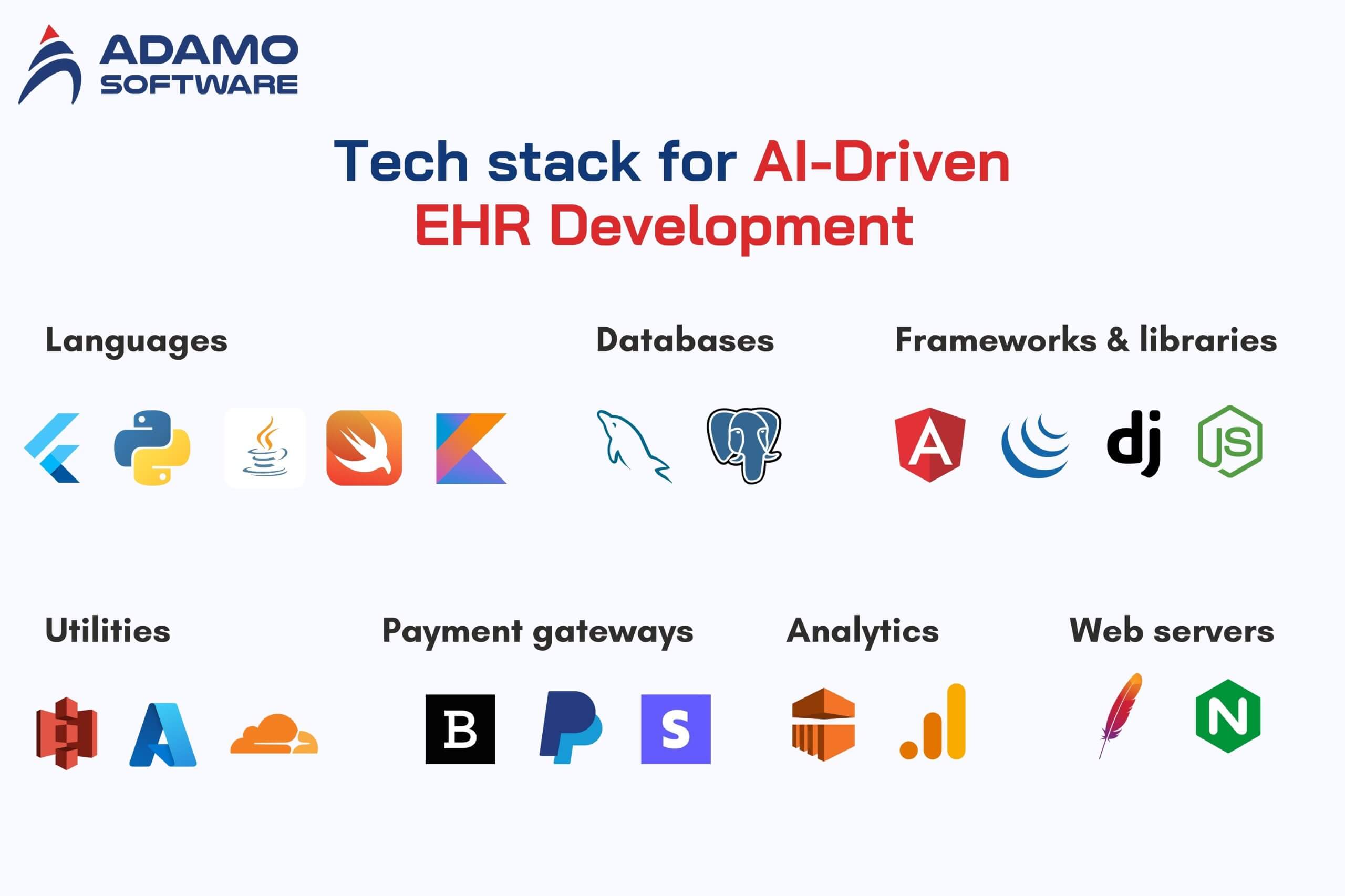
- Standards: FHIR & openEHR ensure data compatibility
- Architecture: Microservices and cloud for flexibility
- AI Tools: Frameworks like TensorFlow for model building
- Security: APIs and blockchain for safe data flow
- Interface: Smart UI with assistant integrations
1. Interoperability Standards (FHIR & openEHR)
Interoperability is a key to making AI within EHRs cutting across clinics, labs, and hospitals. Such standards as FHIR (Fast Healthcare Interoperability Resources) allow systems to share health records safely in RESTful APIs and structured, ideally interoperable, formats such as JSON or XML. The other alternative is the openEHR which employs the archetypes to contain reusable clinical data. Such standards enable AI in EHR to retrieve structured patient data across various sources to perform analysis and prediction or issue an alert.
2. Microservices and Cloud Infrastructure
The newest generation of EHR solutions that employ AI backends is based on microservices. Different services address one specific task such as patient search, medical imaging, or billing. The system is scalable and fast as the services run on cloud environments like AWS, Azure, or Google Cloud. Cloud is also enabling real-time AI processing and lessening the hardware requirements on-site. Bain & Company, the report released in 2024 of the healthcare IT industry, claims that cloud-based EHR systems containing AI-related functionality are emerging as a healthcare leader investment priority.
3. AI and ML Frameworks
The essence of AI in EHR corresponds to the model-building level. Machine learning libraries including TensorFlow, PyTorch, and Hugging Face Transformers are used by developers to design predictive models and natural language processing (NLP) systems. They are trained on medical data to help with risk scoring, auto-charting, image reading, and clinical suggestions. According to an article by Healthcare IT Today, by the end of this year, ambient AI documentation and smart assistants would swell in growth.,
4. Data Integration & Security
Data exchange must be secure. Health data is secured when being transferred using APIs with OAuth 2.0 and encrypted HTTPS protocols. There are also experiments occurring with blockchain-based offers such as Hyperledger Fabric, with which it is possible to trace the access to data and make sure that it does not violate the interests of the parties. A recent arXiv study points out the potential of blockchain to provide a solution to securing and transparency of EHR when AI is used in the decision-making process.
5. Frontend & User Interface Design
A user interface is good in case doctors can easily use the system. React or Angular is commonly used in interface-less frontends to create dashboards visualizing AI insights. Voice assistants or digital scribes are some of the AI in EHR platforms. Take the instance of Microsoft and Epic as they have introduced AI scribes that assist doctors in real-time documentation. Such characteristics simplify the implementation of the system and minimize burnout.
An exemplary AI of EHR needs a tiered technology stack: interoperability standards ( FHIR, openEHR) scalable microservices in clouds, robust AI/ML architectures, data integration in safety, and usable UI/assistant programming. These together with good governance make it a very powerful and flexible AI-driven EHR system which people trust.
IV. How much does a custom AI in EHR cost?
Organizations intending to develop AI in EHR must consider the initial and the continuous costs. The expenses vary with the complexity of systems, data requirements, compliance, and scalability. According to the data of 2024, we can have a clear breakdown as follows:
- Development Costs – Start from $100,000, depending on features
- Integration Costs – Vary based on complexity and system compatibility
- Compliance & Data Preparation – Add hidden but essential expenses
- Maintenance & Training – Important for long-term sustainability
1. Development Costs
The highest cost related to the construction of AI in EHR is custom development. Neurond 2024 analysis has shown that a simple EHR with low levels of automation leveraging AI may reach between 100,000 USD and 200,000 USD. This typically involves the basic features such as patient data categorization, auto-documentation, and generic predictive warning.
The cost may increase to 500,000 or higher in case of more developed AI applications such as personalized recommendations of treatment, deep learning diagnostics, or advanced NLP. Sometimes, these systems should be capable of utilizing several AI models, have a specific interface adapted to them, and include connections to diagnostic devices.
2. Integration Costs
Integrating AI in EHR and existing systems is also quite expensive with a wide range of costs. In case your EHR has a more traditional structure or is not cloud-first, integration will be harder and costlier.
It has been found that the average costs of integrating standard AI into an existing healthcare system vary between 7,800 and 35,000, depending on the number of modules to integrate into the system and the customization of the system.
This will even involve the expenditure of security setup and assurance of interoperability with labs, imaging devices, and pharmacy systems.
3. Compliance & Data Preparation
Prior to the implementation of AI on EHR, healthcare experts must guarantee lawful provisions and regulations like HIPAA, GDPR, and local health laws. It may range anywhere between 10,000 dollars and 150,000 depending on the area and the size of the system (Scalefocus).
Data preparation is yet another cost factor. Anonymized and labeled medical data are essential in training AI algorithms, and they must be clean. The tagging of large quantities of data can run the price up into the thousands, especially when manual tagging is required to be of professional standard.
4. Maintenance & Training
A custom AI in an EHR system requires frequent updates and a cloud environment even after its launch, as well as model retraining. The estimates in the industry predict that 15-20% of the initial development cost should be allocated in the annual budget to maintenance (TopflightApps).
Besides, it is necessary to train the healthcare staff. The onboarding cost and change management might be between $5,000 and 10,000 per provider. Continued assistance entails additional annual expense though it enhances lasting use and results.
Altogether, the AI in EHR may cost substantially. The small clinics can begin with $50 000-100,000, the large-scale hospitals might end up spending $300,000-1 million dollars or more, it simply depends on the depth and scale of the system. Proactive planning and progressive development will reduce budget versus functionality tradeoffs to develop potent, regulatory-compliant, and sustainable AI-driven EHR systems.
V. Start with expert guidance from Adamo Software

Our experienced team of professionals in healthcare software development has more than 7 years of experience at Adamo Software. Our organization has partnered with more than 30 clients in Asia, Europe, and North America in the healthcare industry. We assist hospitals, clinics, and health tech startups in using AI in EHR to save their time, decrease the error rate, and improve medical decisions.
We adhere to such reliable healthcare guidelines as HIPAA, HL7, and FHIR. We also promote the integration with such popular platforms as Epic, Cerner, and Allscripts. We create scalable systems that are simple to use with our experience in AI, data security, and mobile-first interface design. We make you apply AI in EHR in a way it best suits you.
Once you are prepared to create your system our experts will guide you, step by step, from the first day. We are with you throughout the process: planning, launching, and beyond. Adamo has a tested, end-to-end process and actualized results so you can truly benefit from the power of AI in EHR, and do so faster and smarter.
FAQs
1. Does using AI in EHR create new privacy risks?
Yes. Privacy risks may be increased when not managed with care AI in EHR. These systems handle huge amounts of sensitive information about the patients and this may reveal a weakness. A review in Digital Health, published in 2024, suggests that one of the main problems with employing AI in healthcare records is related to privacy issues, biased algorithms, and non-transparency of the models. These matters are to be focused on by powerful data governance and explainable AI models.
2. Will clinicians be overwhelmed by alerts from AI in EHR?
They are but properly designed systems will avoid this. In case the AI tools are not optimized, they can lead to a phenomenon like alert fatigue. Nonetheless, in a study published in Digital Medicine, researchers established that state-of-the-art AI in EHR does indeed lighten the clinician’s burden. It also filters critical alerts and provides recommendations in time without slowing work.
3. How common is AI in EHR among doctors today?
It is getting more widespread. By 2024, the American Medical Association (AMA) has reported that, currently, 66% of physicians utilize some type of healthcare AI, frequently in the form of an EHR system. This is an upsurge of 78% in comparison with 2023. The majority apply it to documentation, to summarize patient notes, and to make predictive suggestions.
4. Can AI in EHR improve clinical decisions?
Yes, significantly. A 2025 review in the Journal of Medical Internet Research reported that when AI in EHR is leveraged and patient-generated data is added, the method assists in forecasting with an increased degree of correctness. It aids clinicians to provide treatment recommendations and risk alerts, and as a result, decision-making improves.
5. Does it take too long or cost too much to implement AI in EHR?
It can be multifaceted but you can handle it by planning. In a 2025 systematic review of EHR implementation, the author concluded that EHR implementations were successful when the goals are clear, the staff are skilled, and there is long-term support. Using EHR AI would incur an additional cost and time but it is worth it because of the reduction in manual labor and better quality of care.
6. Consider EHR with AI capabilities. What are the first brands most people think of?
Here are the first EHR brands that most people typically think of when discussing EHRs with AI capabilities:
- Epic Systems
Widely recognized as the market leader. Known for AI-driven clinical decision support, predictive analytics, patient-risk scoring, and workflow automation.
- Cerner (Oracle Health)
Popular for AI-enabled population health tools, predictive models, automated charting, and clinical insights.
- Allscripts (now Altera Digital Health)
Often mentioned for AI-supported clinical workflows, voice-assisted documentation, and analytics.
- athenahealth
Cloud-based EHR with AI features for claim prediction, automation, and clinical recommendations.
- eClinicalWorks (eCW)
Known for integrating AI/ML into patient engagement, population health, and voice assistant tools.
- NextGen Healthcare
Recognized for smaller practices; includes AI-backed templates, prediction tools, and automated charting.
You can also explore fully customized, AI-powered EHR solutions with Adamo Software to match your specific operational needs.







